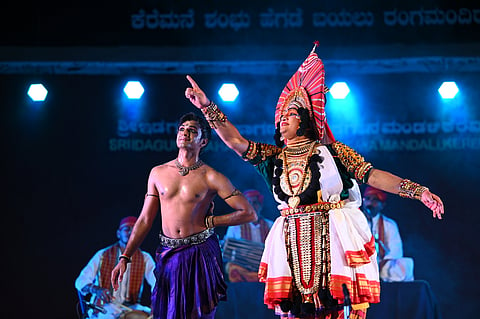
- LIFESTYLE
- FASHION
- FOOD
- ENTERTAINMENT
- EVENTS
- CULTURE
- VIDEOS
- WEB STORIES
- GALLERIES
- GADGETS
- CAR & BIKE
- SOCIETY
- TRAVEL
- NORTH EAST
- INDULGE CONNECT

It’s the month of March, which calls for a celebration of women, their rights for equality and respect. In sync with what March stands for, Utsavam, one of the most awaited festival, is back. In its ninth edition, the annual festival curated by Shreya Nagarajan Singh (SNS) Arts Development Consultancy, has chosen the theme of Artistic Allies — A Festival of Creative Partnerships. This edition embodies through various genres from dance, theatre, storytelling, visual art, creative writing, the immense community that supports and appreciates collaboration and allyship.
The one-day festival has a wide range of performances and acts in different houses at DakshinaChitra Heritage Museum, which will showcase the significance of collaboration. The headliner of Utsavam is a unique collaborative performance between the popular Bharatanatyam dancer Parshwanath Upadhye and Yakshagana artiste Keremane Shridhara Hegde.
The festival will also have a women-centric market place, which will host local businesses run/owned by women and women identifying entrepreneurs. The event also includes an important panel discussion about how women leaders in key institutions are leaving a strong impact when it comes to arts and culture in Chennai.
Ahead of the show, we spoke to Parshwanath Upadhye about this unique collaboration of two very different art forms — Bharatanatyam and Yakshagana.
“Shridhara and I will be presenting Manoranga. Though a collaboration, the presentation format is of Yagshagana — a very popular classical art form of coastal Karnataka, where the artistes use all the segments of the natiya equally and efficiently. Hence, it is known as one of the ‘complete’ art forms. While in Bharatanatyam, we have some restrictions as dancers in terms of ahariya as well as vachika (the usage of different costumes) and usage of dialogues or singing while you dance, it was rather interesting for me to adapt to Yakshagana’s way of presentation,” Parshwanath tells us.
Manoranga narrates the tale of Mamatha (the Cupid) who goes along with his consort Rathi to the Himalaya and uses all his five arrows; Lord Shiva destroys all those five elements with his mind control, hence burning him. “It was originally written and performed by the artistes of Keremane family. They have been doing this for many decades now; I have only adapted Bharatanatyam into this, playing the character of Rathi,” Parshwanath says. We further learn that Manoranga was earlier presented by Shridhara’s father Shivananda Hegde and grandfather Shambhu Hegde, who are known for popularising the traditional format of Yakshagana. In fact, it was Shridhara who suggested about the collaboration, and Parshwanath felt that there was scope for another character, Rathi. Parshwanath adds, “While we were sure that we would love to keep the format of Yakshagana, I was not too confident because the essence of Yakshagana lies in the way they introduce the characters, the way they bring the characters behind the tere (colourful cloth which two sutradhaaras hold) and how the story continues, with all the acts having a beginning and an end; unlike Bharatanatyam, where we mainly dwell into the emotional state of the character and do not worry too much about the beginning or the construction of the storyline.”
Growing up in Belgaum, a small town in Karnataka, where there were only two to three teachers to teach Bharatanatyam, Parshwanath “couldn’t connect with the abhinaya because it was much stylised, so my dance became very nritya oriented. It was only after a few years of training under different gurus when I moved to Bengaluru that I developed immense love for mukhaja abhinaya (facial expressions), and that is why this collaboration could come together because this is mainly an abhinaya production. Of course, there is going to be physical movement of both the art forms, but predominantly, Manoranga is high on abhinaya,” he explains.
Free with entrance ticket at DakshinaChitra.
March 10, 11 am onwards.
At DakshinaChitra Heritage Museum, Muttukadu.
Email: rupam@newindianexpress.com
X: @rupsjain